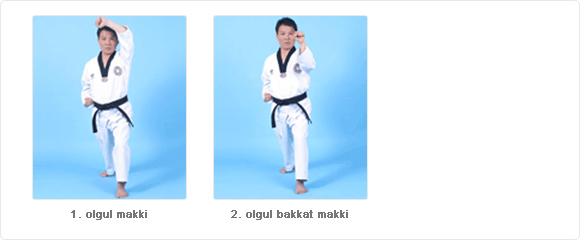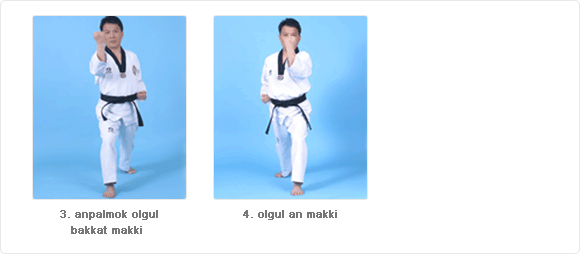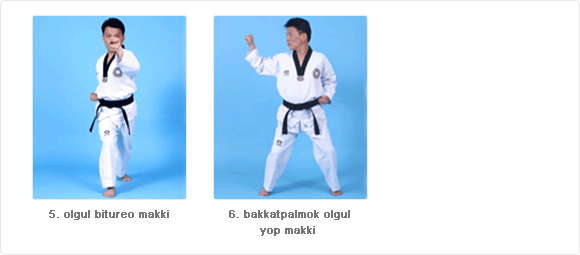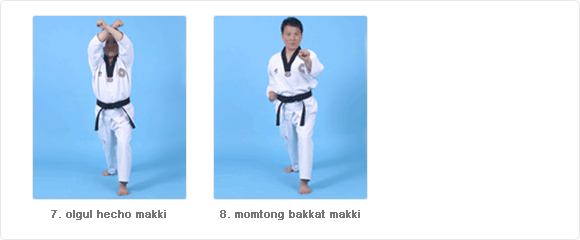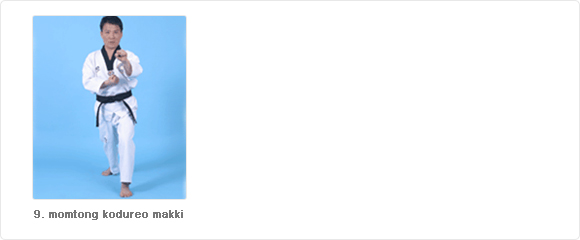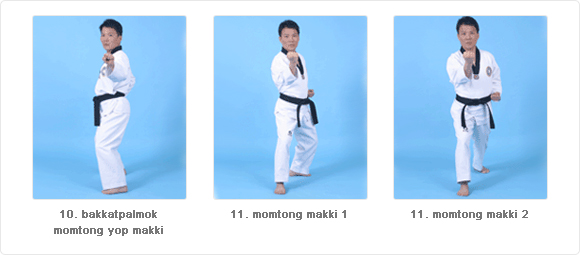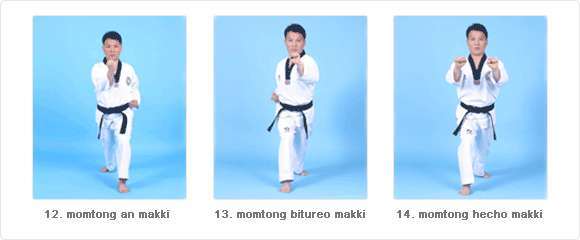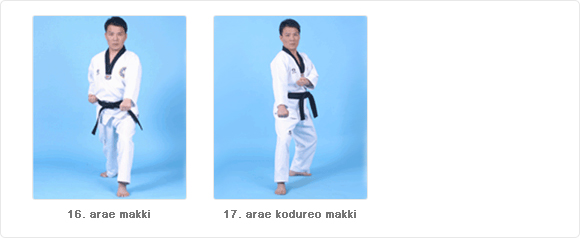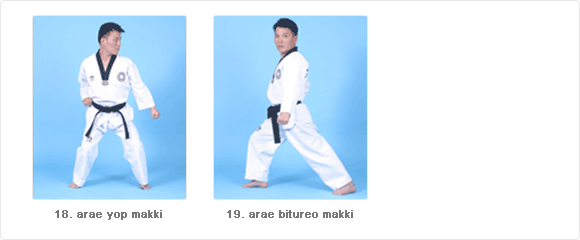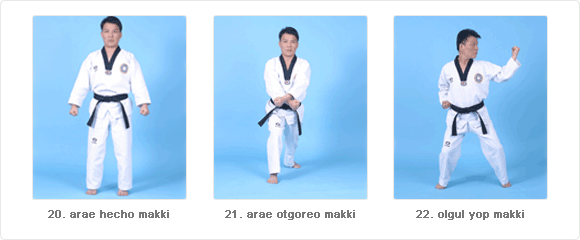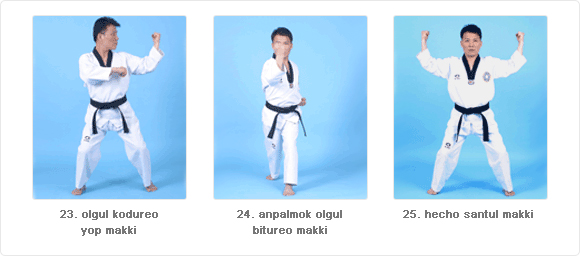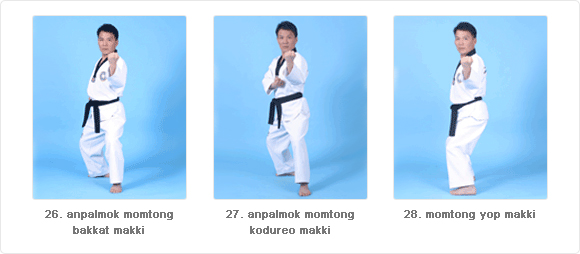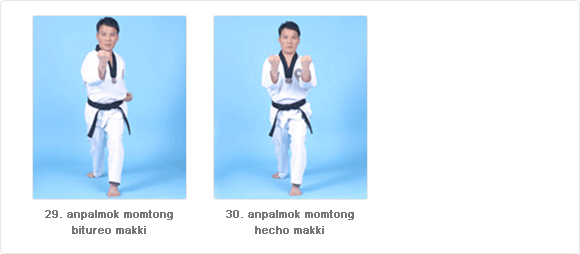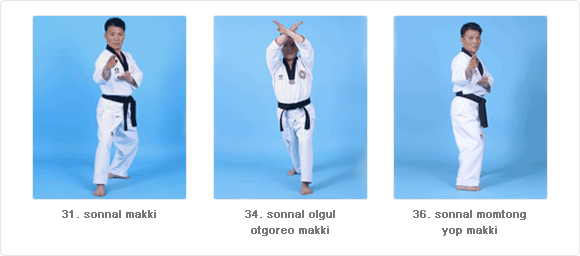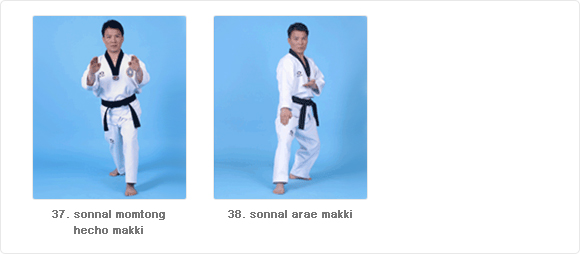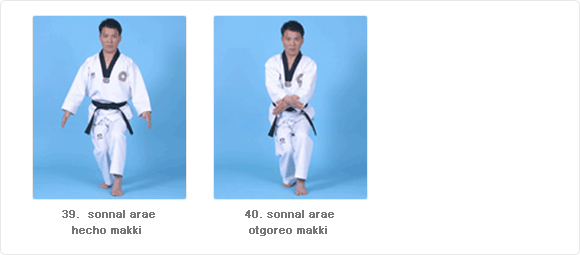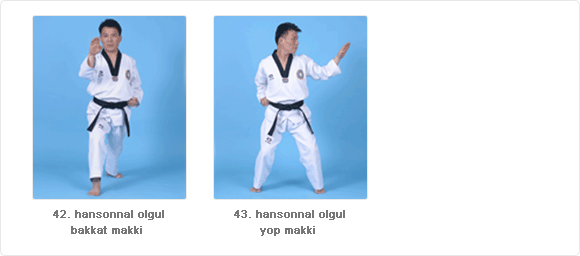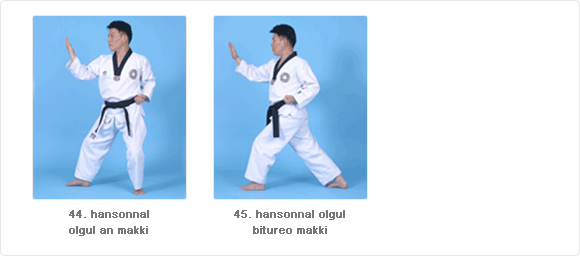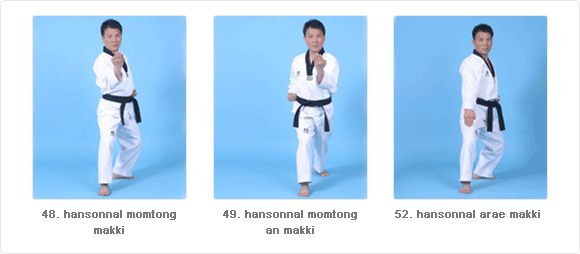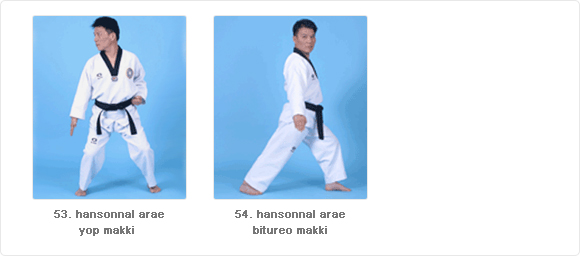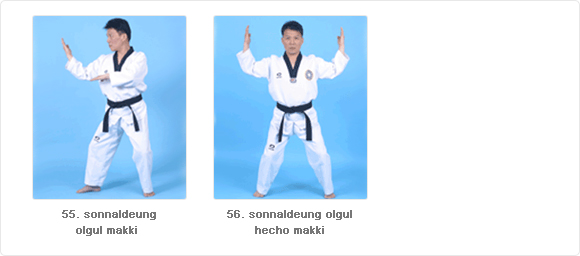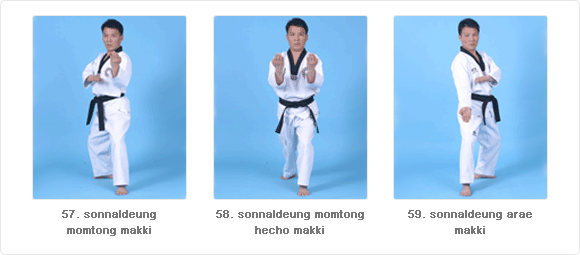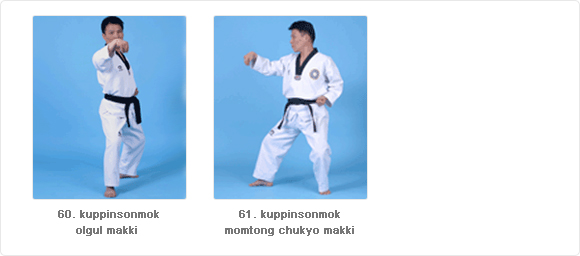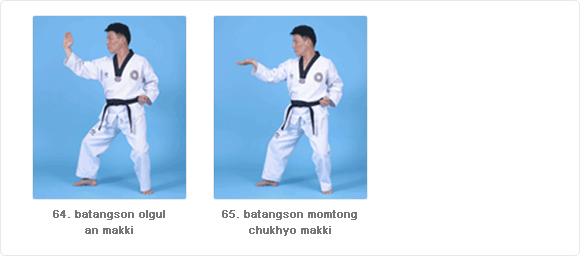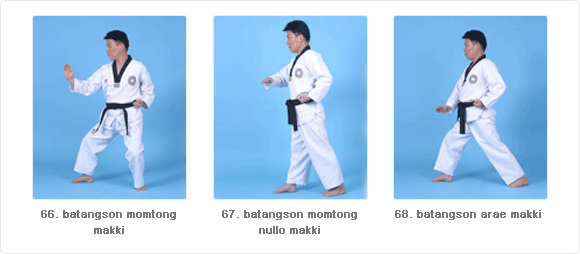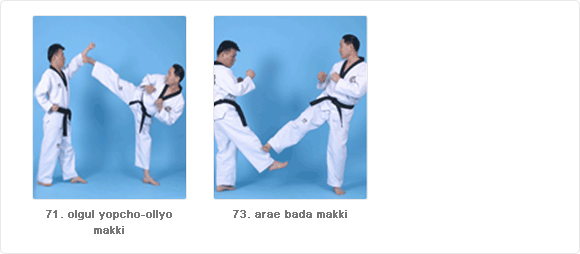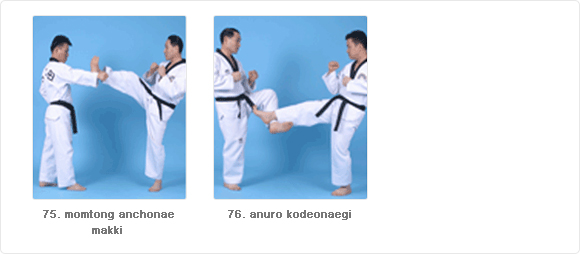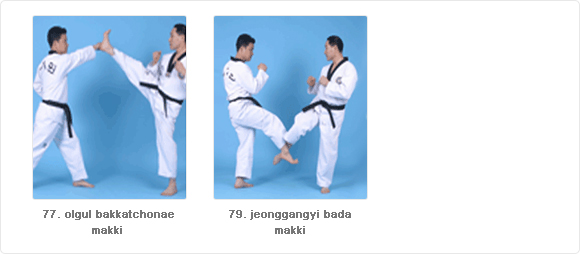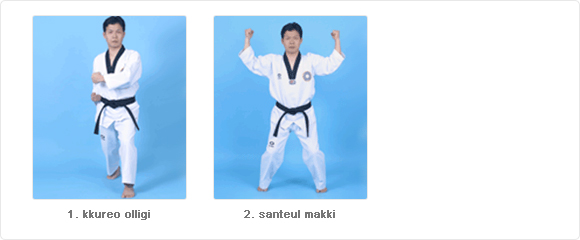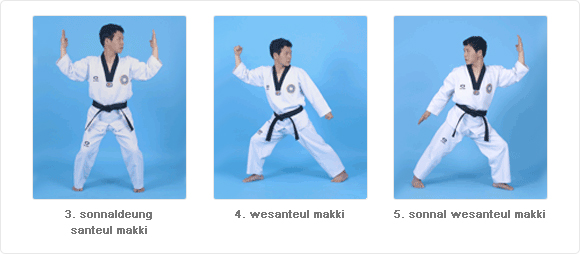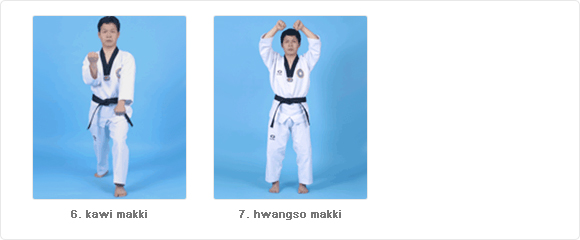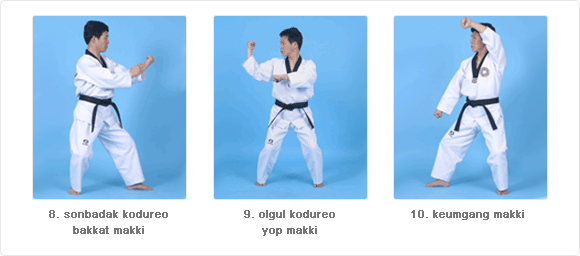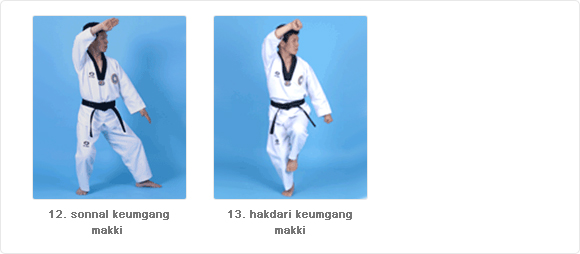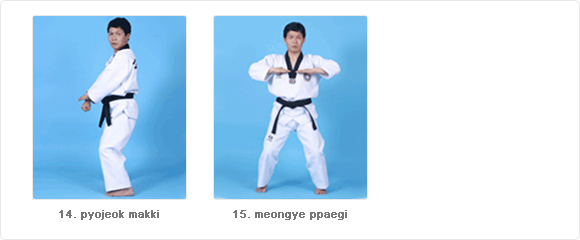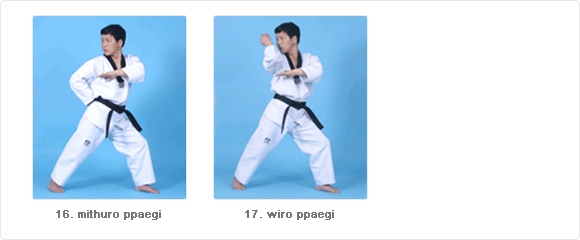The makki (defense or blocking) techniques are to protect oneself from being attacked by one’s opponent. Averting the opponent’s attacks by escaping is another means of protecting oneself. It is often said that running away from a danger is one of the best techniques for self-defense. However it is important to master the techniques of blocking (makki) the opponent’s attacks in case of a face-to-face confrontation. A man of good defense techniques may not necessarily provoke a fighting, although he is capable of winning. To the contrary, a man of insufficient defense capabilities would prove himself stupid if he dares a fighting. Defending oneself from attacks alone could not lead to a final solution, if the other party continues attacking; therefore, it is necessary to apply the techniques of weakening the opponent’s offensive.
That is why most of makki Taekwondo techniques are designed to hurt the opponent in the course of defending oneself by using the wrists or hand blades, which, if trained hard, may inflict impacts on the other party’s vital points, making the latter’s arms and legs incapacitated.
Therefore, makki techniques must be trained hard so that they may function equally as offensive techniques. With this, one may show himself or herself generously, not by winning over the opponent by initiative attacks but by overcoming the latter by mere defense techniques without impairing others. This is indeed a righteous way if a man of virtue that Taekwondo teaches.
For that reason, Taekwondo training is planned to begin with the makki techniques, which will be follows by the training of offensive techniques. That is , Taekwondo never allows any initiative move of attack in its techniques.
Taekwondo uses the bodily parts, of which some are hard when contracted and sharp when opened so as to be applied in offensive techniques while other solid and long parts are applied in defense (makki) techniques. The makki is more effective when makki parts are used in a well balanced position.
Defending with the leg or foot may be strong enough, but the remaining leg or foot has the difficulty in keeping the balance of body so that any mistaken technique may cause a great danger. Therefore, two arms must be always ready to render assistance. In other words, the two arms should be used in makki techniques while the legs are used to keep the balance.
It is made a rule that one of the wrists, especially the outer side of the forearm, is used for makki techniques, which is called “palmok-makki”(wrist blocking).
There is another category of makki techniques called “sonnal makki”(hand blade blocking) which is characterized by the sharpness of hand blade and also by the weakness of deteriorated blocking power due to the wrist point. Therefore, it is a general rule to have the other hand always accompany the main hand to assist. The “palmok-makki”(wrist makki) is usually carried out by one wrist alone, but it may also be assisted by the other wrist, in which case the term of “kodureo makki”(assisted blocking) is used. To the contrary, sometimes a hand blade makki is performed by one hand alone, which is called “hansonnal makki”(one hand-blade blocking). The way of makki(blocking) can be classified as inner makki(blocking from outer side to inner side) and outer makki(blocking from inner side to outer side).
The official terms are described as follows:
- The starting point of makki is defined as follows: Makki starts from the waist level to defend the face; trunk level to defend the trunk, and the shoulder level to defend the lower part(underneath). However, slightly lower or higher is permissible.
Officially Established Terminology
Bodily parts used in makki + target + way of makki = the officially established term or name of technique:
- Outer wrist + face + lift up + makki = olgul makki(face blocking)
- Blocking face by lifting up the outer-wrist is the typical of the face blockings. Of course, there are other means of blocking the face.
- Outer wrist + face + outer makki = olgul bakkat makki (face outer blocking)
- The outer wrist can be used for a face outer blocking. This is simply called face outer blocking, because this blocking is in principle made by the outer wrist.
- Inner wrist + face + outer makki = anpalmok olgul-makki (inner wrist face outer blocking)
- Inner wrist can also be used for an outer blocking, which is called “inner wrist face outer blocking”
- Hand blade + trunk + outer makki = sonnal momtong makki(hand blade trunk blocking).
- Blocking with the hand blade is applied only to the outer blocking. Using hand blade blocking, this is called sonnal momtong-makki except outer blocking.
- One hand blade + trunk + inner makki = hansonnal momtong anmakki (one hand blade trunk inner blocking).
- Blocking with the hand blade is applied only to the outer blocking; therefore, this is called a band blade trunk blocking. One hand blade can be used for an outer blocking as well as an inner blocking.
Thus, simplified forms are used for the blocking terms. Refer to the photos, the words, and the form of the movements as followed pooms.
1. Outer wrist + face + lift-up makki = olgul makki
- The wrist of the blocking arm comes right in front of the center of the face.
- The blocking wrist is one fist’s distance apart from the forehead.
- The other hand’s wrist is situated at the waist side.
(Point of attention)
The blocking arm should be kept slightly lower than the outside of the other arm’s elbow, and the other arm starts from the shoulder’s hight of the other side, keeping the fist directed upward.
2. Outer wrist + face + outer makki = olgul bakkat makki
3. Inner wrist + face + outer makki = anpalmok olgul bakkat makki
4. Outer wrist + face + inner makki = olgul an makki
The use of inner wrist in an inner makki is awkward and less powerful; so, the use of the outer wrist is commonplace, thereby necessitating no specification of “outer wrist” in the term.
5. Outer wrist + face + twist makki = olgul bitureo makki
6. Outer wrist + face + side makki = bakkat palmok olgul yop makki
7. Outer wrist + face + cross makki = olgul otgoreo makki
8. Outer wrist + face + outer makki = momtong bakkat makki
- The blocking fist must be directed toward the body and the end of the fist must be parallel with the shoulder line.
- The outer hand’s wrist should be situated at the waist side, the bottom of the fist kept faced upward.
(Point of attention)
The fist of the blocking arm, in the form of bending backward, is kept slightly lower(one fist’s distance) than the other arm’s elbow, and the other arm is kept slightly apart from the blocking arm’s shoulder, keeping the fist back directed upward from the inner side of the blocking arm.
9. Outer wrist + trunk + kodureo makki = momtong kodureo makki
- The fist-back of the blocking arm is kept directed toward the body.
- The fist-back of the assisting arm is directed downward.
- The blocking hand is kept in the equal form with the outer wrist trunk blocking.
- The elbow of the blocking arm does not stink to the assisting fist.
(Point of attention)
The same method as in the hand-blade blocking, only the hand-blade changed into the fist.
10. Outer wrist + trunk + side makki = bakkatpalmok momtong yop makki
The side-blocking is in principle made by the inner wrist, therefore, the outer wrist must be specified in case it is used in this blocking.
- The fist is kept parallel with the shoulder line, stuck to the side of the trunk.
- The arm-pit is kept open at a fist’s distance, the elbow looking the side of the shoulder.
- The fist-back is kept looking the side the shoulder.
(Point of attention)
The same way as in the outer-wrist trunk outer-blocking.
11. Outer wrist + trunk + inner makki = momtong makki
When the inner – makki was made with left – hand outer wrist in the left – foot stance (or right-foot forward stance, tight – hand forward inflection stance, right – hand tiger stance)
- In all the trunk-inner blocking, the wrist must be kept at the center of the body. In outerblocking, the wrist is situated at the side of the shoulder.
- The elbow is kept open at around 90~120 degrees.
- The blocking fist is kept as high as the shoulder.
- The wrist should not be bent.
- The other hand’s wrist should be kept at the side of the waist, in the form of a bent fist.
12. Outer wrist + trunk + inner makki = momtong an makki
When the left – hand outer wrist makes an inner makki in the right foot stance.
13. Outer wrist + trunk + twist makki = momtong bitureo makki
14. Outer wrist + trunk + pushing makki = momtong hecho makki
- Two fist-backs are kept looking toward the trunk.
- The outer-wrist trunk outer-blocking is applied to both sides.
- The wrist should be kept inside the both sides of the shoulders.
(Point of attention)
The bases of two fists will be crossed with each other looking toward the trunk, and kept in the same form as in the outer-wrist trunk outer-blocking.
15. Outer wrist + trunk + pressing makki = momtong nullo makki
16. Outer wrist + underneath + outer makki = arae makki
- The blocking fist is kept apart from the thigh of the fore-leg by the width of two erected fists.
- The wrist of the other hand will rest on the waist side in the form of bending.
(Point of attention)
The blocking fist will be lifted up to the shoulder’s level and the base part of the fist will face the opposite side of the face. The other hand will be stretched toward the pit of stomach in a state of bent wrist. The elbow of the blocking arm will neither be lifted up nor stuck to the body.
17. Outer wrist + underneath + assisting outer makki = arae kodureo makki
- The same way as in a kodureo sonnal arae makki(assisted underneath blocking by hand-blade)
- The fist is used instead of the hand-blade.
(Point of attention)
The blocking fist with the base looking toward the face will be located in front of the shoulder, nad the assisting fist with its back looking toward the face will be raised up to the ear’s level.
18. Outer wrist + underneath + side makki = arae yop-makki
- The blocking is made by holding the wrist two fists’ distance apart in front of the lateral part of the thing from a juchum seogi stance.
(Point of attention)
The blocking hand applies the same way as in an arae-makki, and yet the other hand will be swung toward the waist on the side of the blocking arm and drawn back toward the waist side at the same time as the arae-makki is enacted.
19. Outer wrist + underneath + bitureo makki = arae bitureo makki
20. Outer wrist + underneath + pushing makki = arae hecho makki
- The fist will be kept at a two-fist distance in front of the lateral part of the thigh.
- The hand will protrude oet slightly in the front.
(Point of attention)
The base parts of the two fists will be crossed with each other toward the trunk, and then the two fists will be lowered to the lower part of the abdomen to make an arae makki by laterally pushing.
21. Inner wrist + face + outer makki = arae otgoreo makki
- The hand-blades will face each other and the wrists will be crossed with each other.
- The two fists cross with each other from the waist on the side of the back foot to make a blocking downward from the center line of the body.
- The arm on the same side as the fore-foot is laid on the down side.
22. Inner wrist + face + assisting + side makki = olgul yop makki
23. Inner wrist + face + kodureo + side makki = olgul kodureo yop makki
24. Inner wrist + face + twist makki = anpalmok olgul bitureo makki
25. Inner wrist + face + hecho makki = anpalmok olgul hecho makki (hecho santul makki)
- In a state of blocking, the two fists will be brought to the hight of the level fo head temple.
- The base parts of the two fists will face each other at the lateral part of the face.
(Point of attention)
The two fists will cross each other below the lower abdomen, the fist-backs facing upward. Raising two arms upward, you make a pushing blocking sidedways in front of the face.
26. Inner wrist + trunk + assisting outer makki = anpalmok momtong bakkat makki
- The blocking fist is as high as the shoulder and it is located on the side of the shoulder.
- The base of the fist of the blocking arm faces the body.
- The arm-pit of the blocking arm will be kept open by the width of a fist.
- The wrist of the other hand fist will be stuck to the waist.
(Point of attention)
The fist of the blocking arm, in a turned-down form, will be located slightly lower(a fist’s distance) than the elbow of the opposite arm, and the opposite arm starts its movement from the inner side of the blocking arm, keeping the fist-back-facing upward and slightly a loof from the shoulder on the side of the blocking arm.It is a general rule that the side makki is made by inner wrist, and the trunk side makki by the outer wrist makes one feel tense in muscle and decreases power and speed.
27. Inner wrist + trunk + assisting + side makki = anpalmok momtong kodureo makki
28. Inner wrist + trunk + side makki = momtong yop makki
A side-blocking is in principle made by the inner wrist. If you make a trunk side-blocking with the outer wrist, you may suffer a muscle tension and the power and speed decrease. The stance for making side-blocking is a juchumseogi.
29. Inner wrist + trunk + twist makki = anpalmok momtong bitureo makki
- The wrist for the twist blocking(biteuromakki) is kept on the same level as the shoulder.
- The wrist of the other hand is located on the waist side in the form of bending.
(Point of attention)
Same as anpalmok-momtong-bakkatmakki, twist the waist because of the shoulder of the blocking arm should be front.
30. Inner wrist + trunk + hecho makki = anpalmok momtong hecho makki
- The inner-wrist trunk outer-blocking is made from the both sides.
- Two fists should be kept not to devidate from the body.
- The base parts of two fists will face the trunk.
(Point of attention)
To begin this blocking, you must keep the wrists crossed with each other, making tje fist-backs face the trunk.
31. Hand-blade + trunk + outer makki = sonnal momtong makki
- The blocking hand-blade is located a position in parallel with the lateral part of the shoulder.
- The finger-tips are kept as high as the shoulder.
- The wrist should not be bent, the palm facing the front.
- The assisting hand keeps its wrist at a position in front of the stomach pit and the hand-blade slightly apart from the body.
(Point of attention)
The palm of the blocking hand is kept facing upward, and the other hand keeps its palm facing backward to begin the blocking. The finger-tips of the other hand are kept parallel with the shoulder and the wrist slightly bent is smoothly lowered, while the finger-tips of the blocking hand pass the front of the nose and the assisting hand is drown toward the stomach pit.
32. Hand-blade + face + side makki = sonnal olgul yop makki.
33. Hand-blade + face + pushing makki = sonnal olgul hecho makki.
34. Hand-blade + face + cross makki = sonnal olgul otgoreo makki.
35. Hand-blade + trunk + outer makki = sonnal momtong makki.
36. Hand-blade + trunk + side makki = sonnal momtong yop makki.
37. Hand-blade + trunk + pushing makki = sonnal momtong hecho makki
- The same as in the trunk bakkatmakki.
- The blocking is made by the hand-blade in a state of an open hand.
38. Hand-blade + underneath + outer makki = sonnal arae-makki
- The blocking hand-blade with the hand-back facing upward will be positioned over the thigh of the fore-leg with a vacancy of two erected fists’ width from the thigh. The wrist should not be bent.
- The wrist part of the assisting hand-blade comes in front of the stomach pit, keeping the hand-blade slightly apart from the body.
(Point of attention)
The palm of the blocking hand is directed toward the face and the tips of the hand-blade are kept as high as the ear. The other hand keeps its palm facing backward and the wrist part in parallel with the shoulder, and the hand is lowered smoothly in a state of slight bendind to begin the blocking.
39. Hand-blade + underneath + hecho-makki = sonnal arae hecho makki
- The same way as in the area hecho-makki(pushing blocking).
- The blocking is made by the hand-blade in a state of an open hand.
40. Hand-blade + underneath + cross makki = sonnal arae otgoreo makki.
41. One hand-blade + face + lift-up chukhyo makki = hansonnal olgul makki.
42. One hand-blade + face + outer makki = hansonnal olgul bakkat makki.
43. One hand-blade + face + side makki = hansonnal olgul yop makki.
44. One hand-blade + face + inner an makki = hansonnal olgul an makki.
45. One hand-blade + face + twist bitureo makki = hansonnal olgul bituro makki.
46. One hand-blade + trunk + outer makki = hansonnal bakkat makki.
47. One hand-blade + trunk + outer makki = hansonnal bakkat makki.
48. One hand-blade + trunk + inner makki = hansonnal momtong makki.
49. One hand-blade + trunk + inner makki = hansonnal momtong an makki.
- The same way as in the trunk outer-makki, only the blocking hand changed into a hand-blade.
50. One hand-blade + trunk + twist makki = hansonnal momtong bitureo makki.
51. One hand-blade + trunk + underneath + push makki = hansonnal momtong nullo makki.
52. One hand-blade + underneath + outer makki = hansonnal arae makki.
- The same way as in the areamakki, only the blocking hand changed into a hand-blade.
(Point of attention)
The blocking hand-blade is raised as high as the shoulder, the base of the hand-blade is directed toward the face on the opposite side. The other hand in a state of turned-down fist will be smoothly strectched toward the thigh part on the blocking side. The elbow of the blocking arm should not be lifted up and should be kept aloof not to stick to the body, at the time of blocking.
53. One hand-blade + underneath + side makki = hansonnal arae yop makki.
54. One hand-blade + underneath + twist makki = hansonnal bitureo makki.
55. Hand-blade back + face + outer makki = sonnaldeung olgul makki
56. Hand-blade back + face + outer makki = sonnaldeung olgul hecho makki.
- The same way as in the hecho-santeulmakki(pushing wide-open blocking).
- The hand-blade is used for this blocking. hansonnal arae makki.
57. Hand-blade back + trunk + assist + outer makki = sonnaldeung momtong bakkat makki.
- The same way as in the hand-blade trunk-makki, the palm of the blocking hand facing the body this time.
- The fist-back of the assisting hand faces upward.
(Point of attention)
The hand-back of the blocking hand is kept facing upward and the palm side of the opposite hand facing the body to begin the blocking. The finger-tips of the opposite hand are kept as high as the shoulder and the elbow in a slightly bending state will be lowered smoothly, while the blocking hand’s finger-tips will pass the front of the nose and the assisting hand will be drawn toward the pit.
58. Hand-blade back + trunk + push makki = sonnaldeung momtong hecho makki.
- The same way as in the inner-wrist trunk pushing-makki.
- The hand-blade back in a state of open hand is used for the blocking.
59. Hand blade back + underneath + outer makki = sonnaldeung arae makki.
60. Bent wrist + face + lift up makki = kuppinsonmok momtong makki.
61. Bent wrist + trunk + lift up makki = momtong chukyo makki.
62. Bent wrist + trunk + outer makki = kuppinsonmok momtong bakkat makki.
63. Palm hand + face + lift up makki = batangson olgul makki.
64. Palm hand + face + inner makki = batangson olgul an makki.
65. Palm hand + trunk + lift up makki = batangson momtong chukyo makki.
66. Palm hand + trunk + inner makki = batangson momtong an makki
- The palm hand is positioned in parallel with the stomach-pit, the finger-tips facing oblquely upward.
- The opposite hand wrist in a state of bent fist will rest on the waist side.
(Point of attention)
The palm hand will be raised as high as the shoulder before it is bent backward to thrash down to the front of the stomach-pit in order to make a blocking.
67. Palm hand + trunk + pressing makki = batangson momtong nullo makki.
- The hand-blade will kept facing upward, the palm hand kept in front of the stomach-pit.
- There will be a gap of two erected fists’ width between the blocking hand and the body.
- The opposite hand wrist will rest on the waist side in the front of a bending fist.
(Point of attention)
The blocking hand will be lifted to bring the palm part as high as the shoulder before it is pressed down to make a blocking.
68. Batangson arae makki.
69. Fore sole + face + kick up makki = olgul apcho-ollyo makki.
70. Fore sole + trunk + kick up = momtong apcho-ollyo makki.
71. Foot blade + face + kick up = olgul yopcho-ollyo makki.
72. Foot blade + trunk + kick up = momtong yopcho-ollyo makki.
The above 4 blocking patterns can be used in defending or attacking by a kick-up or a simple chagi toward the front or sideways.
73. Foot blade + underneath + counter makki = arae bada makki.
74. Foot blade back + face + inner kick-away = olgul an chonae-makki.
75. Foot-blade back + trunk + inner kick away = momtong anchonae-makki.
76. Foot blade back + underneath + push off = anuro kodeonaegi.
77. Foot back + face + outer kick-away = olgul bakkatchonae makki.
78. Foot back + trunk + outer kick-away = momtong backkathchonae makki.
79. Shin + underneath + counter makki = jeonggangyi bada makki.
Teuksu Makki (special blocking)
So far the explanations have been made regarding the use of each bodily part, i.e., wrist or hand blade or foot, etc., but from now on the integrated use of two parts, which is called “teuksu makki” (special makki), will be described. This special poom is used in practical makki techniques or is part of the flow of motions in the course of proceeding makki techniques.
1. Kkureo olligi (drawing up)
(Point of attention)
The arm, in a stance of bending forward(apkubi), will be pulled slightly toward the side-line of the shoulder before it is drawn up to the front of the stomach-pit with an open gap of an erected fist’s width between the arm and the pit.
2. Santeul makki (wide open makki).
- In a state of blocking, the fists of both arms are kept at the height of the temple.
- The base parts of the two fists will face each other along the side of the face.
- In a juchumseogi stance, the posture looks like an inner-wrist side-blocking the face and an outer-wrist side-blocking the face having been enacted simultaneously.
(Point of attention)
The hand used in the inner-wrist side-blocking the face will make the fist-back face the front at the height of the face, and the hand used in the outer-wrist side-blocking will keep its back facing the body and make a blocking by twisting the waist.
3. Sonnaldeung santeul makki (hand blade back wide open makki)
4. Wesanteul makki (single hand wide open makki).
- The arm blocking the lower part of the body will keep its fist as high as a two fists’ width from the lateral part of the thigh.
- The arm blocking the upper part will keep the fist as high as the temple of the head.
(Point of attention)
The arm blocking the upper part will start its action from a ready stance at the time of inner-wrist outer-makki of the trunk, while the arm blocking the lower part from a ready stance for an arae-makki.
5. Sonnal wesanteul makki (hand blade single hand wide open makki)
- The same way as in the single-hand wide-open makki, this time using the hand-blade.
- The arm blocking the upper part keeps its finger-tips as high as the top of head.
6. Kawi makki (scissors makki)
- The same form as in the araemakki and inner-wrist outer-blocking the trunk.
(Point of attention)
In the form of starting an araemakki, the elbow of the arm to block the trunk will be bent so that the fist is brought to the waist on the side of the hand blocking the lower part. The two arms will cross each other simultaneously in blocking.
7. Hwangso makki (bull makki)
- The form of the two fists having blocked the face simultaneously.
- The fists are kept apart from each other at an erected fist’s width, and a gap of the same width exist between the fist and the face, too.
(Point of attention)
In the form of a basic ready stance, the two fists will lift their bases upward over the face, where the fists are twisted so that the fist-back may face the fore-head.
8. Sonbadak kodureo bakkat makki (palm assisting side makki)
9. Olgul kodureo yop makki (assisting face side makki)
- The blocking hand will keep its fist base directed toward the side of the face and rest beside the lateral part of the shoulder.
- The assisting hand will rest in front of the chest in the form of a turned-down fist, and the arm keeps slightly aloof from the body.
(Point of attention)
This is to make a side-makki in the stance of a small doltzeogi.
10. Keumgang makki (diamond makki)
- This consists of an arae makki and an olgul makki.
- At the time of a backward-inverted stance, the hand blocking the lower part will be positioned above the thigh of the front foot.
(Point of attention)
The lower part blocking hand stars its action from the starting point of the blocking arm at the time of an araemakki, the face blocking hand does from the starting point of the blocking arm at the time of a face-blocking.
11. Keumgang momtong makki (diamond trunk makki)
- This consists of a face-blocking and an inner-wrist out-blocking of the trunk.
(Point of attention)
In the stance of a small doltzeogi, the two arms are drawn toward the chest to conduct both face-blocking and inner-wrist out-blocking of the trunk stimultaneously.
- For a diamond-makki, it is essential that a face-blocking and another blocking are conducted stimultaneously.
12. Sonnal keumgang makki (hand blade diamond makki)
- The same way as in the diamond arae-makki, except that the hand-blade is used this time.
13. Hakdari keungang makki (crane diamond makki)
- This is an action having done a diamond-blocking in a crane stance.
- The lower part blocking hand will rest in front of the lateral part of the trunk.
14. Pyojeok makki (target makki)
- The inner-wrist of the other hand is used to make an inner-makki against the palm as a target.
15. Meongye ppaegi (yoke pull out).
16. Mithuro ppaegi (underneath pull out.)
17. Wiro ppaegi (upward pull out).
Jabki (grasping)
1. Agwison palmok jabki.
- An arae-hand is used to grasp the opponent’s wrist in the course of the latter’s downward hitting.
2. Sonmok jabki (cf. Poomsae Chonkwon)
3. Palmokbitreuo jaba kklki
- After the action of a hand-blade twisting-makki of the trunk, the wrist is slowly turned toward the hand-blade to grasp by twisting and drag in.
4. Balmok jabki (cf. Mureup kkukki motion and Poomsae Koryo)
5. Mori jabki (cf. Taegeuk 7 jang)
6. Okkae jabki (cf. Taegeuk 7 jang)
7. Mok jabki
- A jipkeson(pincers-hand) is used to grasp the opponent’s neck.

